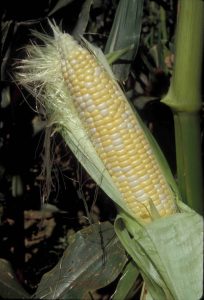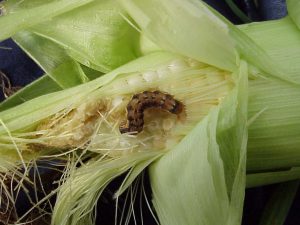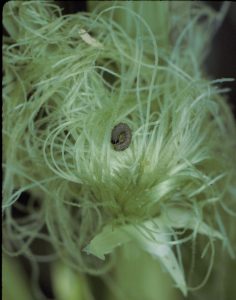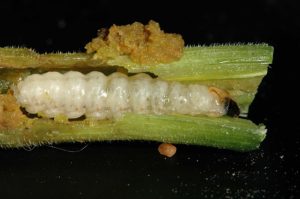Sweet Corn IPM Newsletter No. 7 – August 4, 2017
 Sweet Corn IPM Newslettter No. 7 – August 4, 2017
Sweet Corn IPM Newslettter No. 7 – August 4, 2017
Click on photos to enlarge.
INCREASING CORN EARWORM ACTIVITY
Fall Armyworm Threat Remains High in Many Fields
SITUATION
“Abnormally dry” conditions continue in much of the state, and growers are spending a lot of time keeping up with irrigation. Harvest is progressing on early corn and overall quality looks good. Corn earworm populations have increased a bit over last week, and fall armyworm numbers are high in some fields.
European corn borer: Moth captures were very low this week, suggesting an end to the first generation of this pest. Larval feeding activity was also very low and did not exceed threshold in any fields.
Corn earworm: Moth counts increased moderately in most locations this week, putting most fields on a spray interval for silking corn. A 6-day spray interval for corn earworm was recommended for silking fields in Auburn, one Cape Elizabeth site, one Dayton site, Lewiston, Levant, Nobleboro, Palmyra, Poland Spring, and one Wells site. A 5-day spray interval was recommended for silking fields at one Dayton site and New Gloucester. A 4-day spray interval was recommended in Biddeford, one Cape Elizabeth site and Garland.
- Corn Earworm; photo by David Handley
- Fall Armyworm on Corn Silk; photo by David Handley
Fall armyworm: Moth counts are down a bit from last week, however counts are still very high at some locations and present a significant threat to both young plants and silking corn. Most silking fields are now under a spray interval for corn earworm, which should also keep fall armyworm in check. However, in silking fields that are not currently spraying for earworm, weekly applications for fall armyworm based on the three moths caught per week threshold, may not provide adequate protection, especially under hot, dry conditions; and growers should consider more frequent applications. A spray for fall armyworm on silking corn was recommended in Sabattus. Other sites, including Auburn, Lewiston, Biddeford, Cape Elizabeth, Dayton, New Gloucester, Nobleboro, and Wells were also over the 3-moth threshold, but are now on a spray schedule for corn earworm.

Squash vine borer moths were above the spray threshold of 5 moths in Biddeford, Cape Elizabeth and New Gloucester this week. Growers with squash and pumpkins should be on the lookout for vine borer symptoms and protect squash plants if moths or damage are seen.
We are also starting to see more disease pressure in squash and pumpkins. Both powdery mildew and black rot (aka gummy stem blight) have starting appearing in pumpkin fields this week. For management suggestions check the New England Vegetable Management Guide. If you need a copy please call us, or you can find it online.
- Squash Vine Borer Larva; photo by Jeffrey Hahn, Univ. of Minnesota Extension
- Spotted Wing Drosophila Larvae in Raspberry; photo by David Handley.
Spotted wing drosophila: Fly counts have been rising over the past week, and most sites are now at a level where control measures are required to prevent infestation. Blueberries, raspberries and blackberries are especially at risk, and should be sprayed at a 5- to 7-day interval to maintain clean fruit. For details, visit our Spotted Wing Drosophila blog.
Sincerely,
David T. Handley
Vegetable and Small Fruit Specialist
Highmoor Farm, P.O. Box 179, 52 US Route 202, Monmouth, ME 04259, 207.933.2100
UMaine Extension Diagnostic Research Lab, Pest Management Unit, 17 Godfrey Drive, Orono, ME 04473, 1.800.287.0279
| Location | CEW Moths |
ECB Moths |
FAW Moths |
%Feeding Damage |
Recommendations / Comments |
|---|---|---|---|---|---|
| Auburn | 2 | 0 | 52 | 0% | 6-day spray interval recommended on all silking corn |
| Biddeford | 13 | 0 | 8 | 31% | 4-day spray interval recommended on all silking corn |
| Bowdoinham | 1 | 0 | 0 | 1% | No spray recommended |
| Cape Elizabeth I | 2 | 0 | 8 | 2% | 6-day spray interval recommended on all silking corn |
| Cape Elizabeth II | 9 | 0 | 21 | 4-day spray interval recommended on all silking corn | |
| Charleston | 0 | 1 | 1 | 1% | No spray recommended |
| Dayton I | 4 | 0 | 1 | 0% | 5-day spray interval recommended on all silking corn |
| Dayton II | 2 | 0 | 7 | 3% | 6-day spray interval recommended on all silking corn |
| Farmington | 0 | 2 | 0 | 0% | No spray recommended |
| Garland | 8 | 0 | 0 | 0% | 4-day spray interval recommended on all silking corn |
| Lewiston | 2 | 0 | 6 | 0% | 6-day spray interval recommended on all silking corn |
| Levant | 3 | 0 | 0 | 0% | 6-day spray interval recommended on all silking corn |
| New Gloucester | 5 | 0 | 73 | 0% | 5-day spray interval recommended on all silking corn |
| Nobleboro | 2 | 0 | 6 | 2% | 6-day spray interval recommended on all silking corn |
| North Berwick | 0 | 0 | 0 | 0% | No spray recommended |
| Oxford | 0 | 2 | 17% | One spray recommended for FAW on pre-tassel corn | |
| Palmyra | 3 | 0 | 0 | 0% | 6-day spray interval recommended on all silking corn |
| Poland Spring | 2 | 1 | 0 | 37% | 6-day spray interval recommended on all silking corn |
| Sabattus | 1 | 0 | 6 | 2% | One spray recommended for FAW on all silking corn |
| Wales | 1 | 0 | 1 | 0% | No spray recommended |
| Wayne | 0 | 1 | 0 | 0% | No spray recommended |
| Wells I | 2 | 0 | 8 | 0% | 6-day spray interval recommended on all silking corn |
| Wells II | 0 | 0 | 0 | 0% | No spray recommended |
CEW: Corn earworm (Only fresh silking corn should be sprayed for this insect.)
ECB: European corn borer
FAW: Fall armyworm
| Moths caught per week | Moths caught per night | Spray interval |
|---|---|---|
| 0.0 to 1.4 | 0.0 to 0.2 | No spray |
| 1.5 to 3.5 | 0.3 to 0.5 | Spray every 6 days |
| 3.6 to 7.0 | 0.6 to 1.0 | Spray every 5 days |
| 7.1 to 91 | 1.1 to 13.0 | Spray every 4 days |
| More than 91 | More than 13 | Spray every 3 days |
Thresholds apply only to corn with exposed fresh silk. Lengthen spray intervals by one day if maximum daily temperature is less than 80°F.
European Corn Borer Thresholds
Whorl stage: 30% or more of plants scouted show injury.
Pre-tassel-silk: 15% or more of plants scouted show injury.
Silk: 5 or more moths caught in pheromone traps in one week.
IPM Web Pages:
UMaine Cooperative Extension Integrated Pest Management
Penn State Pest Watch for Sweet Corn
UMass Amherst Integrated Pest Management
Where brand names or company names are used, it is for the reader’s information. No endorsement is implied nor is any discrimination intended against other products with similar ingredients. Always consult product labels for rates, application instructions and safety precautions. Users of these products assume all associated risks.
The University of Maine is an equal opportunity/affirmative action institution.




